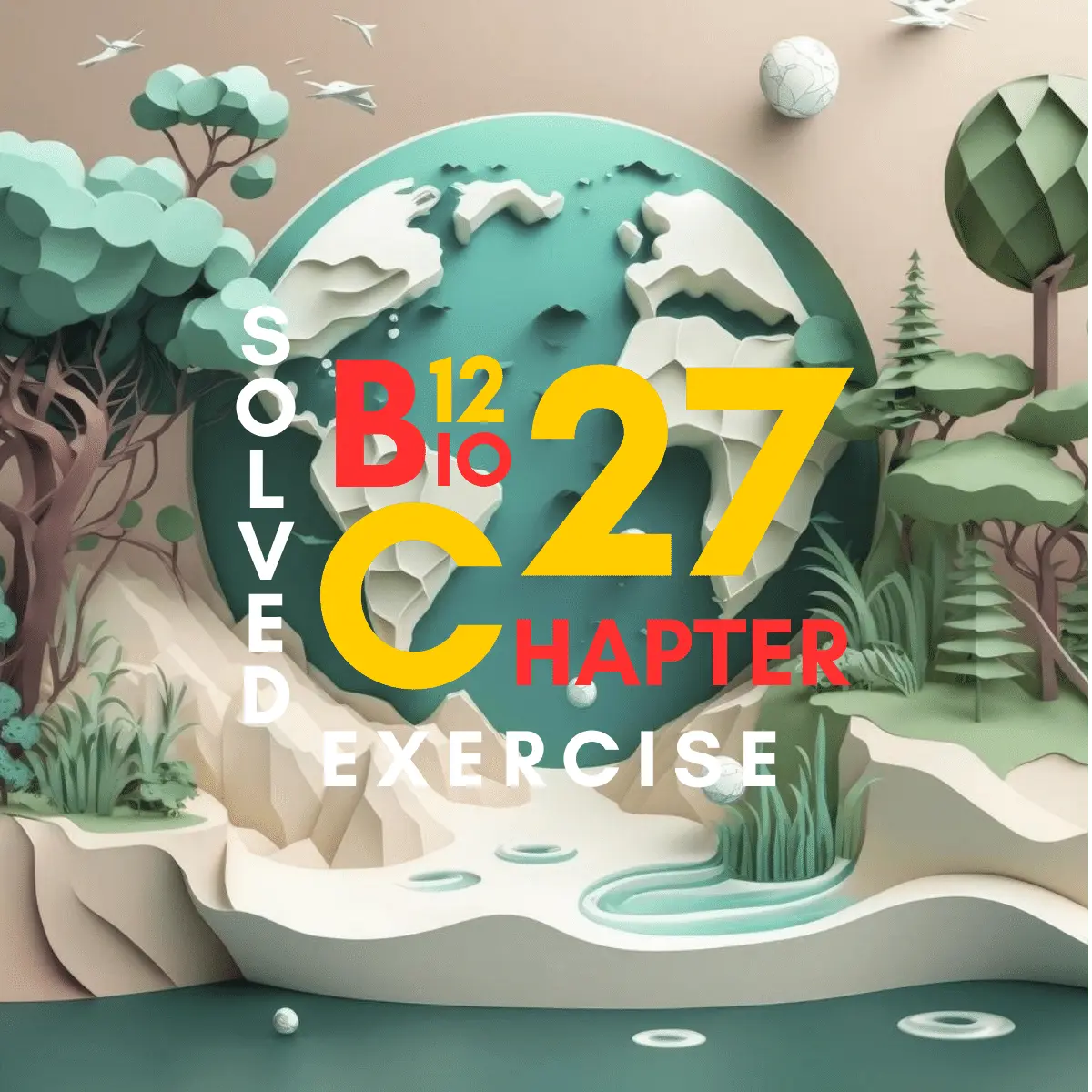MAN AND HIS ENVIRONMENT
FILL IN THE BLANKS
Q.01: Fill in the blanks:
(i) The most widely used source of energy on earth is _______. (sun)
(ii) When energy changes from one form to another form some _______ is done. (work)
(iii) Air, water and soil are the resources, which come in category of _______ resources. (renewable)
(iv) There are seven classes of food; water, carbohydrates, proteins, vitamins, fats, fibers and _______. (minerals)
(v) To save energy actually refers to the _______ of energy. (conservation)
MCQs
Q.02: Each question has four possible options. Encircle the correct answer.
(i) Which of the country has the highest rate of human population:
(a) Australia
(b) Africa
(c) Asia
(d) North America
ANSWER: (c) Asia
EXPLANATION: Asia has the highest rate of human population globally, housing over 4.6 billion people.
(ii) If the population is above the carrying capacity what must happen:
(a) It must immediately cure
(b) It can remain stable indefinitely
(c) It can continue to increase
(d) It must eventually decline
ANSWER: (d) It must eventually decline
EXPLANATION: When a population exceeds its carrying capacity (the environment’s ability to support it), resources become insufficient, leading to competition, scarcity, and ultimately a decline in the population as the ecosystem struggles to sustain such high numbers.
(iii) What is our principal source of energy?
(a) Nuclear energy
(b) Geothermal energy
(c) Solar energy
(d) Tidal energy
ANSWER: (c) Solar energy
EXPLANATION: The sun is Earth’s principal energy source because: (1) It directly provides heat and electricity (solar panels). (2) It indirectly powers other sources like wind, water, and even fossil fuels through various processes.
(iv) Batteries store which type of energy:
(a) Electrical
(b) Mechanical
(c) Chemical
(d) Nuclear
ANSWER: (c) Chemical
EXPLANATION: Batteries store chemical energy by converting it into electrical energy during discharge and reversing the process during charging. This chemical energy is released or absorbed through electrochemical reactions within the battery, enabling it to store and release electrical power.
Q.03: SHORT QUESTIONS
(i) What is ozone layer?
ANSWER:
Ozone Layer:
“Ozone layer is a layer of atmosphere extending from 10 to 50 km above earth, which filters most of UV radiations and protects us from these harmful rays of the sun.”
(ii) What do you mean by non renewable resources?
ANSWER:
Non-Renewable Resources:
“Non-renewable resources are exhaustible resources which once consumed can never be replaced.”
Examples: Fossil fuels (coal, oil & natural gas), metals and non-metallic minerals.
(iii) What is the difference between deforestation and a-forestation?
ANSWER:
Deforestation:
“Clearance of vast area of forest for lumber, planting subsistent crops, or grazing cattle is called deforestation.”
A-forestation:
“A-forestation is establishment of new forests where no forests existed previously.”
(iv) Do you know about biodiversity?
ANSWER:
Biodiversity:
“Biodiversity refers to the total number of different species within an ecosystem and resulting complexity of interactions among them.”
(v) What is water pollution?
ANSWER:
Water Pollution:
“Water pollution is the contamination of water bodies, such as lakes, rivers, oceans, or groundwater, by harmful substances, making it unfit for human consumption or damaging aquatic ecosystems.”
The main causes of water pollution are untreated sewage, oil and detergents.
(vi) Define greenhouse effect.
ANSWER:
Greenhouse Effect:
“The greenhouse effect is the natural process where certain gases in Earth’s atmosphere, such as carbon dioxide and water vapor, trap and retain heat from the sun, preventing it from escaping back into space.”
This process warms the planet, supporting life as we know it, but human activities, particularly the burning of fossil fuels, can enhance this effect and contribute to global warming.
(vii) What is acid rain?
ANSWER:
Acid Rain:
Sulphur dioxide and nitrogen dioxide emitted in the air during the burning of fossil fuels, combined with water vapours in the atmosphere forming acids e.g.,
Nitrogen dioxide + Water vapours ⟶ Nitric acid + Nitrous acid
Sulphur dioxide + Water vapours ⟶ Sulphurous acid + Sulphuric acid
Days later and often hundred and thousand kilometers away from the source, the acid falls either dissolved in air or as microscopic dry particles called acid rain.
(viii) What is algal bloom?
ANSWER:
Algal Bloom:
“An algal bloom is a rapid increase in the population of algae (microscopic or macroscopic) in a water system.” This often results in a visible discoloration of the water, with the algae reproducing quickly under favorable conditions such as high nutrient levels and warm temperatures.
Q.04: EXTENSIVE QUESTIONS
(i) Can you differentiate between renewable and non-renewable resources with example? How man exploited these resources?
ANSWER:
Consult the textbook at page 264 — 268.
(ii) Can you explain the “population Explosion” its causes, consequences and control.
ANSWER:
Consult the textbook at page 269 — 270.
(iii) What is pollution and pollutant, which type of pollution causes ozone layer depletion, green house effect and acid rain.
ANSWER:
Consult the textbook at page 272 — 273.
(iv) Can you explain the phenomena of “eutrophication” by which type of pollution it may occur and why?
ANSWER:
Consult the textbook at page 275.
(v) Why is there a need of protection and conservation of environment?
ANSWER:
We need to protect and conserve the environment because:
Our survival depends on it: A healthy environment ensures clean air, water, food, and a stable climate for us and all life.
- It protects our health: Pollution and degradation harm our well-being.
- It supports our economy: Many jobs and industries rely on natural resources.
- It’s our responsibility: Protecting the planet ensures its health for future generations and preserves the diversity of life.
NOTE: Please go through these solutions and give your opinion about the quality of the work. You may also give suggestions to improve the contents. Thanks!

